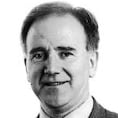The Church of St Joseph and the Immaculate Conception in Bohola, Co Mayo is 150 years old this year. Its foundation stone was laid in 1858, less than a decade after the Famine. It is concrete expression of the triumph of faith and hope over traumatic experience. There are many such churches throughout Ireland.
Between 1841 and 1851 (just seven years before the foundation stone was laid) the population of Bohola dropped from 4,300 to 3,000, a drop mainly due to deaths from starvation and associated illnesses.
In 1880 there was another famine in the area. Then parish priest Fr Thomas Judge wrote to the Mansion House Relief Fund in Dublin on February 20th 1880: "the state of distress is becoming worse every day. The appeals of the poor hungry creatures is most pitiable. They go with tears in their eyes when they are told there is nothing to give."
He continued: "The great majority of families in this parish are small struggling tenants who earn the rent in England and try to live on potatoes, when that fails it is sure to be famine for them, but when both fail, ie earnings from England and crops at home, their state is deplorable indeed. There are at the moment 500 families at the end of their provisions now eating their few seed potatoes they preserved up to this after pawning every available thing they could. You may well imagine the state of a poor family without food, without fire and now without bedclothes in this inclement season. 'Will you for God's sake send us something as soon as you can'."
Destitution
This is the background against which most church building by our
major Christian
denomination took place in Ireland, one of famine, destitution and deepest privation.
It suggests an extraordinary attachment and commitment to the tribal religion after so much oppression. Catholic Emancipation was less than 30 years old when the foundation stone was laid for Bohola church. And, though the penal laws were honoured more in the breach than the observance, for many decades before Emancipation in 1829 they had been largely successful in reducing Ireland’s Catholic population to powerlessness, ignorance and poverty. That population’s allegiance to its faith, however, was not extinguished.
You might say that the church building programme in Catholic Ireland of the mid-19th century, and in such circumstances, represents the heroic phase of modern Irish Catholicism. It would be replicated by Irish emigrants elsewhere in the English-speaking world, particularly in the US. The foundation stone of St Patrick’s Cathedral, New York, was also laid in 1858. It has been said that St Patrick’s was built by the pennies of the Irish poor.
Determination
The Catholic Irish, wherever they went, honoured a faith that they believed saw them through dungeon, fire, sword, and famine. That spirited determination was manifest among some of the more well-known who were baptised in Bohola.
Martin Sheridan was baptised there in time of famine, 1881. Ireland's greatest Olympian, he emigrated to the US at 19 and, over a 14 year period won nine Olympic medals, three world all round championships, 12 national (American) championships, and more than 30 Canadian, metropolitan, and regional championships. All in track and field events.
Bill O'Dwyer, baptised at Bohola in 1890, emigrated to the US in 1910 and became US ambassador to Mexico and New York's 100th mayor. His younger brother Paul was baptised in Bohola in 1907. He too emigrated to the US, was president of New York's City Council in the 1970s and became one of the great US civil rights lawyers of the 20th century.
Bill Keary was baptised in Bohola in 1897 and became president of the Empire State Building in New York. The sanctuary in Bohola's church is dedicated to the Keary family.
The same spirit which drove the impoverished Catholic Irish to build churches to their God as they starved at home also drove their ambition to better themselves in this life abroad. Churches, such as that in Bohola, are a monument to the spirit of those dead generations. Its story is told in a new book The Church of St Joseph and the Immaculate Conception 1864-2014, available from Canon Michael Joyce, parish priest at Bohola, Claremorris, Co Mayo or via www.mayobooks.ie or from annjimulroy@eircom.net.
Patsy McGarry is Religious Affairs Correspondent









